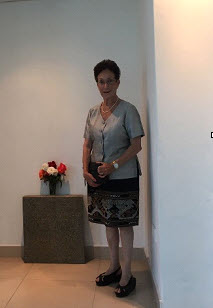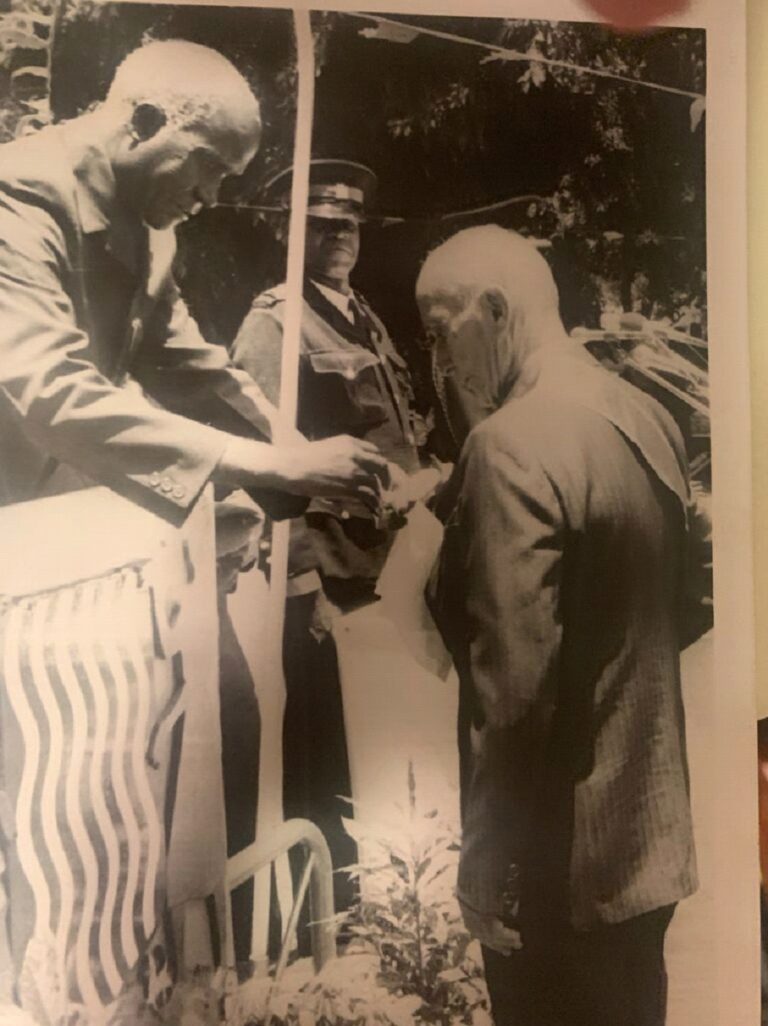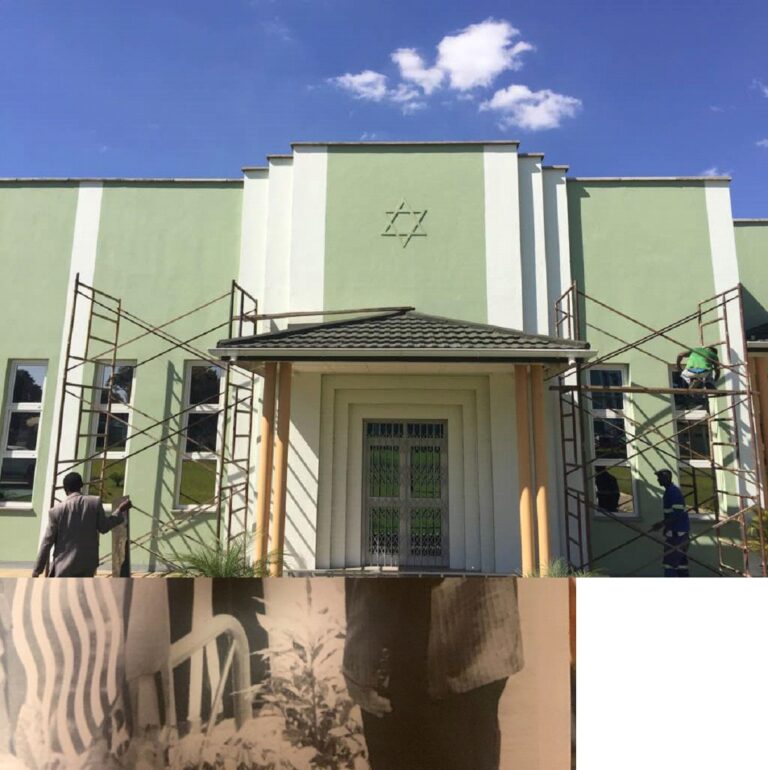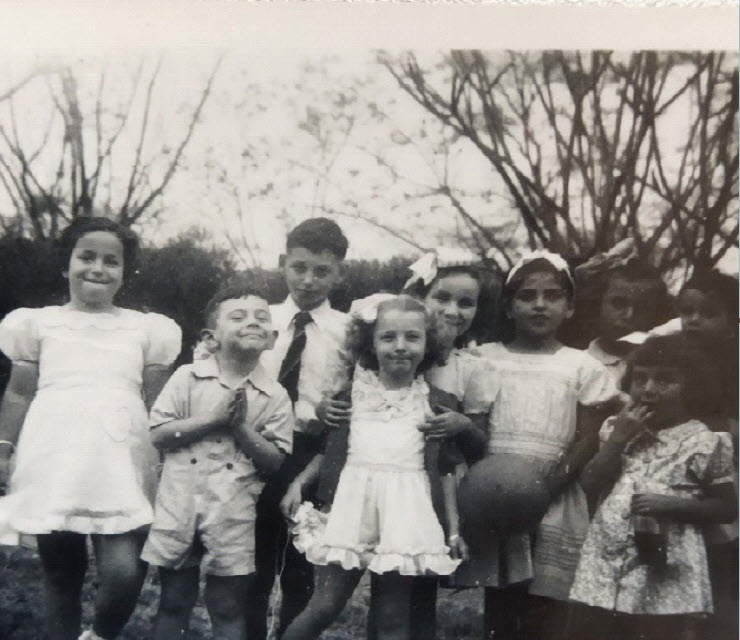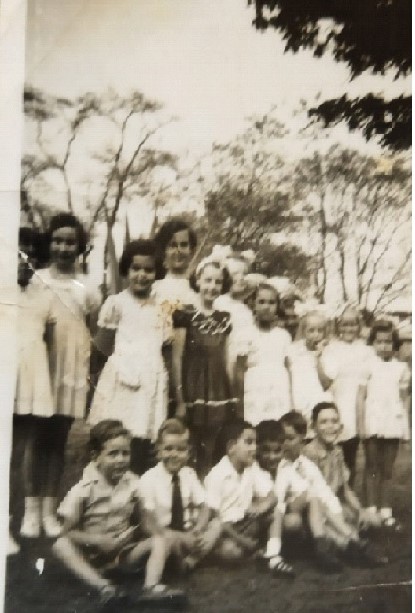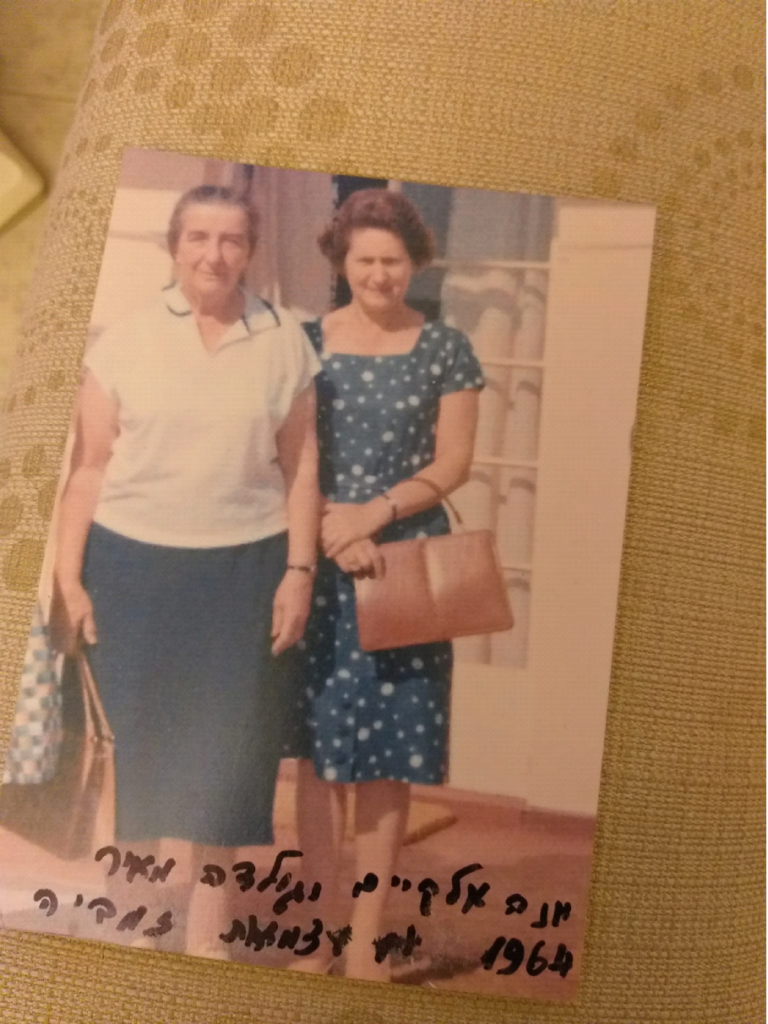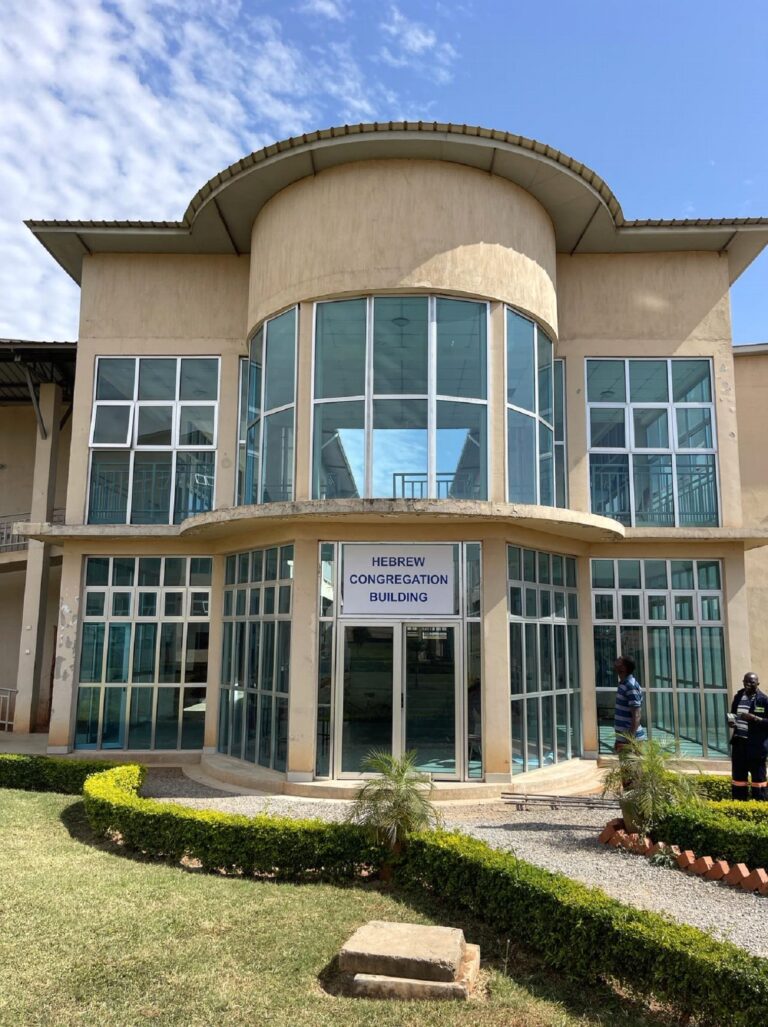Jewish childhood on the Copperbelt, Zambia
Aviva Elkaim Ron
12th March 2024
Much has been written about Jewish life and businesses on the Copperbelt, thanks to Mark Abrams and Mervyn Blumberg, so I will add some words about our childhood, in the 1940’s to 1960’s. The Jewish children in the Copperbelt towns were connected by a special friendship, as our parents got us together for weekend visits, High Holidays, birthdays and picnics on the Kafue bank.
Katie Menashe on the left, Rona Hoffman is the girl in the middle front, and me Aviva Elkaim behind her. About 1950.
The few Jewish families from Sakania, just across the border in the Congo, between Ndola and Mufulira were usually included in these activities. These families were all refugees from Rhodes and gave us the taste for borekas and the Ladino language.
Our parents didn’t spend Sundays playing golf or boating, not only because Jews were not accepted to the Golf and Boating Clubs. With between 10 and 40 Jewish families in each town, our parents understood the importance of contact with other Jews on the Copperbelt. Our parents understood that most of us did not have Jewish friends in our age group at school and this contact was a significant factor in the low rate of assimilation and mixed-marriages.
A significant number of us immigrated to Israel after high school and university studies. Most of our parents were refugees who appreciated the haven that Zambia gave them. Most of them were also ardent Zionists, and understood the yearning for independence. Several Jews actively promoted independence, like Simon Zukas from Luanshya and my father Hanania Elkaim, who supported the movement for independence of Northern Rhodesia from the British empire and were later recognized as Freedom Fighters. We had many “schlichim” coming through to raise support for Israel, and some of the first Zambian leaders had Jewish employers who held meetings so the schichim could have their say. These workers heard the content of the meetings, understood that we Jews had got rid of the British, and asked for our help.
Hanania Elkaim received the Order of Distinguished Service, from President Kenneth Kaunda in May 1990. See picture on the left.
As for the women, almost all were active in WIZO, and I remember them sewing knickers for children to send to Israel in the early days.
I can’t remember any of the Jewish children having grandparents on the Copperbelt. For us, grandparents were people that gentile children had – they came from England once every few years and disappeared. Or they were people we saw every 2-3 years if we travelled to South Africa, like my mother’s parents. So Hanukkah presents were not a big deal and most parents didn’t try to compensate for Christmas presents. But we had lots of aunties and uncles, because that’s what we called the parents of our friends. Some of us had real aunties and uncles, the Katz family had three brothers and a sister in Ndola, and they somehow were double aunts and uncles. Aunty Rose Katz bred ridgeback dogs and many of our families had the puppies, so we were also dog-brothers and sisters, which is a very special relationship.
We all benefitted from Dr Manya Damie, the Jewish woman from Poland who studied medicine in Italy, came to Northern Rhodesia with her Italian husband. He changed his mind about converting, left and Dr Damie became the first lady doctor for the Rhodesian Railways. After jabbing the butts of enough railway workers, including Sir Roy Welensky, she became everybody’s family doctor in Ndola. Dr Damie delivered babies too, including my brother and many of the Jewish families on the Copperbelt came to her – she saved many of them from dying of malaria, black fever, yellow fever and no-colour fevers. She was fiercely Jewish but I don’t remember her ever attending a religious service. Dr Damie came to Israel in early 1961 to end her days and is buried in Kfar Shaul cemetery. In 1990 we got the Ndola Municipality to have our street (Main Street) renamed Dr Damie Street.
Our communities were too small to support a rabbi for any length of time and we were not enthused with those who did come. They wanted us to get kosher meat flown in from Zimbabwe, which was a nuisance and expensive. We kept our faith by not mixing milk and meat and getting sausages without pork from the Jewish butcher in Luanshya who kept a special machine for making these pure beef sausages. Our faith and attendance at Shabbat and holiday services with our own chazan and “ba’al tfila”, Jacob Katz, were good enough for us. If we really needed a Rabbi, until 1960 (when the Congo blew up) we fetched Rabbie Moise Levy from then Elizabethville, now Lumumbashi, in the Congo to do what was needed.
If we needed a mohel for circumcision, we later had a Jewish anaesthetist, Dr Harold Slomowitz, and a Jewish dentist, Dr Paul Lee, who did the honours. Preparation for bar-mitzvah was done by Max Katz, the oldest of the Katz brothers, and I don’t recall any of the girls on the Copperbelt having a bat-mitzvah. We thought it was a South African or Zimbabwean invention and we couldn’t be bothered.
Most of us went to primary school in our towns, and most of the girls were at the Dominican Convents. I started at the age of two, as I was a nuisance in my playground – the sweet factory that my father started when he wanted to stop working on the roads. The sweet factory was also used as the Jewish events hall High school was another story as getting a good education meant going to boarding school. Some of the boys went to King David or Herzliya in Cape Town (like my brother Nissim). When it came to my turn, a precedent had been set when Miriam Messerer from Mufulira was sent to Redhill, a fancy school in Johannesburg, that specialized in country bumpkins. So I was sent there, hated it and escaped when I needed emergency surgery for appendicitis and my father had to fetch me from Johannesburg by car. On the way back (two full days by car), I convinced him I wasn’t going back and we managed to get me enrolled in Salisbury Dominican Convent starting after the surgery (in those days we waited for the surgeon to come from Lusaka to operate in Ndola for 2 days a month. Dr Damie decided she couldn’t operate and that I should wait for the surgeon from Lusaka.
We had a shul in most of our towns – Mufulira, Kitwe, Ndola, Chingola and Luanshya. One condition in the sale of the Ndola shul (in 1990) to the Catholic Diocese next door was to keep the Magen David and the foundation stone on the building. Through negotiations with the Bishop, we finally managed to get the Magen David back after renovation of the shul and adjacent community hall. The original foundation stone is also kept in the now Community Centre, in the alcove that had the aron kodesh (see photos from 2017).
Most Friday nights, Ndola shul had a minyan. As the number of Jewish families dwindled after Independence in 1964, the managers of hotels would phone my father to let him know there was a guest with a Jewish name. The guest was questioned and if he consented, he was collected for the service and Shabbat dinner in our home. This went on till the 1980’s.
Ndola had an international airport serving the Copperbelt and the most exciting event we had for Independence in October 1964 was the visit of the late Golda Meir (see photo with my mother Yona Elkaim). Golda Meir was in transit on the way to Lusaka, so she only chatted for an hour and the bag of oranges she brought were shared by the entire Jewish community.
I had already immigrated to Israel by then (end of 1960) but continued to visit my parents almost every year, till my father passed away in 1991 and we brought my mother to Israel. I was fortunate enough to visit Zambia almost every year after that too, and had the privilege of teaching at the Copperbelt University School of Medicine from it’s opening in 2017 till 2019.
I assume you all know that the proceeds of the sale of the shuls were later donated. In 2014 the Council of Zambian Jewry decided to give US1 million for the first buildings to start the Copperbelt University School of Medicine and US$1 million to renovate the floor in the Tel Aviv Medical School housing the Public Health Department, with some of this amount to be used for collaboration between the two schools. In 2023 the main building was officially named the Hebrew Congregation Building.
Seeing this sign on the building brings such good memories to our childhood, growing up Jewish in Zambia. This is a lasting tribute to the efforts of our parents and all the Copperbelt Jewish Congregations.
